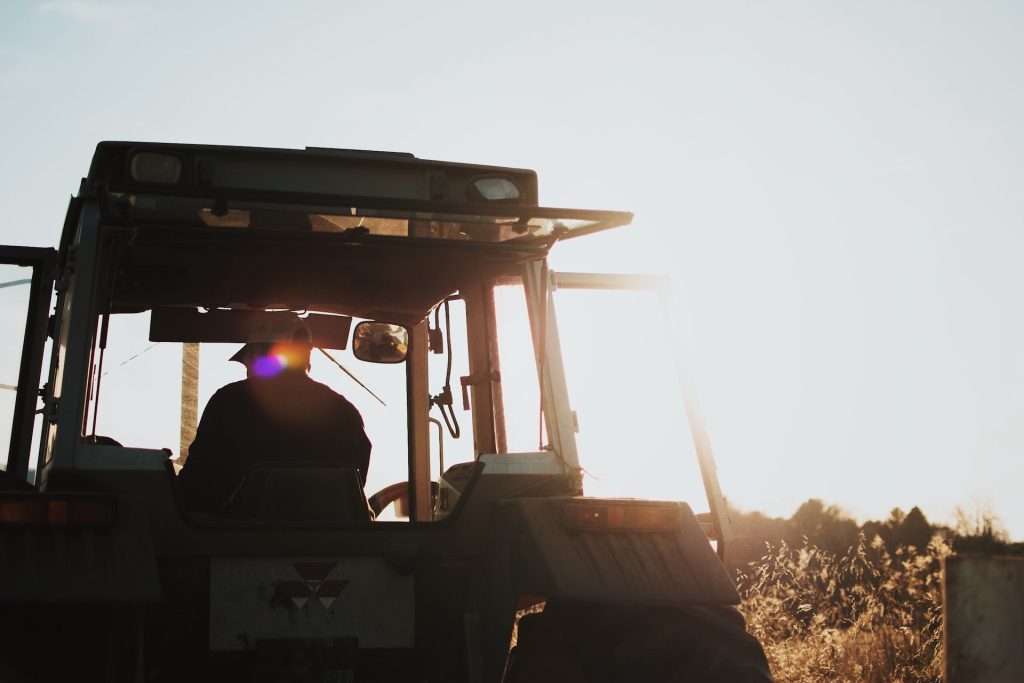What size tractor do I need?

Buying a tractor is a big decision, especially if you haven’t worked with one before or have changed your farming habits due to recently growing or downsizing your land. There’s the cost to consider, along with the type of work that you will be using the tractor for.
Tractors can massively improve the efficiency of your work on the land, but it’s important that you find a tractor that is suitable for your needs and won’t end up costing you more money or time in the long run.
In this guide, we’ll look at the different types of tractors that are best suited to work on smallholdings and farms, depending on their size and purpose.
What size tractor do I need?
The size and type of tractor you need are mainly based on the kind of work you will be using it for and how many acres you need to cover. For example, you can use a small garden tractor with around 20 horsepower (HP) if your smallholding has three acres. However, you would need a larger compact or utility tractor with approximately 25 horsepower if you are covering over 45 acres of land.
The table below shows the type of tractor you may need based on the size of the land you work on.
AcresTractor TypeHP1-4Lawn or Garden Tractor15-295+Subcompact Tractor25-3510+Compact Tractor35-5020+Compact or Utility Tractor45+
Continue reading to find out which size tractor you should buy depending on how many acres you have and the purpose of the land.
What size tractor do I need for one to two acres?
There is only so much produce or livestock that you can keep on a smallholding with roughly one or two acres of land. You will likely be able to do many of the jobs yourself with a wheelbarrow and perhaps the help of handheld machinery. However, two acres of land is still a challenge to maintain if you only have a small lawnmower or you need to transport timber or other heavy materials on a regular basis.
Due to the limited size of the land, a large tractor would be underused. Instead, you would probably find a garden tractor, lawn tractor or a subcompact tractor to be a better option. These small tractors can help with mowing the grass and assist you when it comes to transporting any fruit or vegetables that you may have grown.
The main difference between lawn and garden tractors is that lawn tractors are predominately used for cutting grass, while garden tractors can cut grass and complete a number of other tasks. Garden tractors can usually be fitted with equipment such as tillers, back blades and snow blowers. This can help you save both time and energy as you won’t have to manually complete the tasks yourself.
Garden tractors also tend to have a heavier build than lawn tractors, although they often have smaller cutting blade widths than subcompact tractors. Most subcompact tractors are diesel-powered, while lawn and garden tractors often have a petrol engine. This makes subcompact tractors more powerful and able to complete heavier duties.
Due to the size of small tractor models, they are easy to manoeuvre and light enough that they won’t leave large tire tracks in the yard or on the grass. Lawn and garden tractors can have between 15 to 29 HP capability, while subcompact tractors can have up to 35 HP.
What size tractor do I need for three to ten acres?
A smallholding with three to ten acres is enough room for a small orchard or additional livestock grazing and outbuildings. The size of the land is probably too big for a lawn tractor to handle, especially as they can only mow the grass. A better option would probably be a garden or subcompact tractor as they can be fitted with a variety of attachments that can help with heavier work.
Some of the attachments that you can use with garden or subcompact tractors can help you to haul and transport small loads of manure, fertiliser and pesticide. You can also add attachments that can help you plough, cultivate and till the land. Garden tractors tend to have a cutting blade width of around 46 to 54 inches which can be used to landscape your land. It’s important to match up the right attachment size with your tractor so that they work properly.
Subcompact tractors usually have a four-wheel drive which helps when manoeuvring the vehicle around larger properties. You can choose the horsepower depending on the type of work that you are planning to use the tractor for.
What size tractor do I need for 11 to 20 acres?
Subcompact and compact tractors are good options if you are looking to cultivate land that is around 11 to 20 acres. They normally have four-wheel drive, as well as two or three-cylinder diesel engines and fuel tanks that are able to hold around seven gallons of fuel.
The main difference between subcompact and compact tractors is their size. The larger frame of compact tractors means that they can be used on rugged terrain and to pull heavy loads. They generally have bigger buckets so that they can carry heavier materials. Most compact tractors have between 35 and 50 HP engines which help to complete tasks with optimal efficiency.
One thing to consider is that these larger tractors require more storage space. This can pose a problem if you have limited room to store machinery and equipment, especially if you don’t want to leave your tractor out in the elements.
Subcompact tractors offer many of the same benefits as compact tractors do, but they take up less space and typically cost less. They usually have a smaller frame but are still capable of pulling heavy loads, as well as ascending and descending slopes. However, they don’t tend to be designed for travelling over rugged ground, especially densely wooded areas.
Depending on the type of land that you are working on, you may prefer to buy a compact tractor as they are better equipped than subcompact tractors to deal with uneven ground. However, subcompact tractors are generally easier to store because they are smaller and easier to manoeuvre into tight spaces, such as a shed or garage.
Subcompact tractors tend to have engines with between 25 and 35 HP, which is slightly less than compact tractors. This does mean that they are better designed to handle smallholding that has less than 15 acres of land.
What size tractor do I need for over 20 acres?
It’s advisable to choose a model that has over 45 HP if you want to use the tractor on land over 20 acres. However, a tractor with a minimum 50 HP engine is usually a better bet for heavy-duty tasks. A utility tractor is a good option as they generally have over 40 HP engines, with some models exceeding 100 HP. The frame of utility tractors is generally larger than compact tractors, which helps with hauling large quantities of materials and debris. You can also use a compact tractor as they generally have engines of between 35 and 50 HP.
Utility tractors can handle heavy-duty tasks such as clearing large portions of land and clearing deep snow. Depending on the model, you may also be able to attach agricultural implements such as forklifts and harrows. They can also pull heavier loads such as trailers and horseboxes, which subcompact tractors may not be able to handle.
When deciding on the right tractor, it’s best to choose a tractor that is large enough to haul the materials that you need but not so large that you struggle to store or manoeuvre it. A good bet is to get a tractor that has a loader on top and a large engine so that you can plough the ground (even through tough soil) and move large quantities of soil if necessary.
You will also need to choose between diesel or gear drive tractors. Tractors with hydrostatic transmission don’t require the driver to depress the clutch and are generally considered more user-friendly. However, gear-drive models are usually more powerful and affordable than hydrostatic options.
What size tractor do I need for commercial farming?
If you run a farm, you need a large tractor model that can withstand heavy-duty activities on a daily basis, such as large crop operations or livestock maintenance. If possible, it’s a good idea to choose a farm tractor with over 85 HP, although some larger models can have an engine of up to 450 HP. Farm tractors generally have a four to six cylinder diesel engine, which is more powerful than their petrol counterparts. Diesel engines can also have a longer lifespan than petrol engines as they are water-cooled and can therefore operate at a consistently lower temperature.
Depending on the size of your farm, you may have enough space or tasks to warrant a fleet of tractors. This could mean that you buy a variety of different tractor sizes to complete the different levels of work. For example, you may have a subcompact tractor to help move around livestock feed as well as a utility tractor to plough multiple fields and distribute soil and seed.
Many larger farm tractors come equipped with extra leg space, GPS and air-conditioning. They might also be fitted with a sound system, heating and adjustable seating to make the drive as comfortable as possible.
FAQs
What factors should I consider when buying a tractor?
There are various key components that may impact which tractor you decide to buy. Some of the main factors to consider include the engine, hitches and transmission. As can be expected, you need a powerful engine if you want to use the tractor for heavy-duty tasks. Diesel engines are usually a good bet as they tend to be more powerful than petrol engines. If you only need a tractor to work on a few acres, however, you can opt for an engine with lower horsepower.
As with the engine, transmission is also a key factor when it comes to the performance of your tractor. You may prefer to use foot pedals, in which case you could buy a tractor with hydrostatic transmissions. Alternatively, you could choose a tractor with synchro-shift transmissions, which lets you operate the transmission using a control stick. Foot pedals are commonly considered easier to operate whilst control sticks are better at maintaining speed.
Tractor linkage also impacts the type of attachments that the vehicle can pull. The three-point linkage (or three-point hitch as it is sometimes known) is mainly used to pull ploughing equipment along with a variety of other implements. The linkage helps give the tractor more traction as it helps to transfer the weight and resistance of the attachment to the tractor’s wheels.
What tractor equipment should I buy?
There are different attachments that you can buy for tractors that can help you to complete various jobs. These include:
plough – helps to break up soil, control weeds and bury crop residuetrailer – able to transport loads and materialsbaler – helps to gather haybox blade – able to level ground, move dirt and dig ditchesbuckets – can be used to transport loose material such as grain, gravel and dirt
Summary
The tractor size that you need will depend on how much land you will be working on and the type of tasks that you will need to use it for. You can use small tractors with lower horsepower, such as a garden tractor if your smallholding covers under ten acres. Subcompact tractors can be used on between 25 to 35 acres of land, although a compact tractor is better for dealing with heavy-duty tasks as it has a larger and sturdier frame.
Larger tractors are better at covering more land, especially if you fit them with additional implements such as ploughs and blades. However, smaller tractors are easier to manoeuvre and store whilst still being able to complete a number of less strenuous tasks such as mowing the grass and transporting lighter goods.
Also read:
What are the different types of tractor used in agriculture?
Tractors: Where are they manufactured?
Best tractors by hp (horse power)




